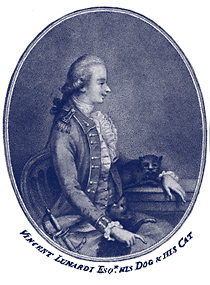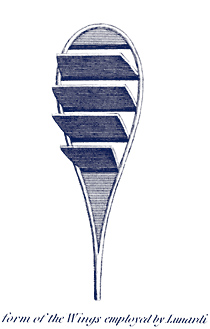| |
Vincenzo ”Vincent” Lunardi (1759- 1806) was a young
diplomat from the kingdom of Naples who had come to England as Secretary
to the Neapolitan Ambassador. When he had heard about Jaques Charles’
successful balloon flying in France 1783, he applied for leave of absence
to learn balloon flying himself.
James Tytler (1745 -1804) had flown hot air balloon over Edinburgh in 1784
and thus became Scotland's first aeronaut and the first Briton to
fly.Tytler was a tragic person. He was a gifted and cultivated writer,
known as one of the editors of Encyclopædia Britannica, but he was also an
eccentric drunkard. Tytler became in 1793 indicted for sedition by the
High Court of Justiciary and fled to Ireland and then to the United States
where he died.
But the English were still sceptical to balloon voyages. Lunardi had
announced that he intended to make England’s first manned balloon flight
in the spring of 1784, but had meet several setbacks. But on the 15th of
September he at last succeeded. But not without initial problems.
An audience of 150 000 persons, including the Prince of Wales himself,
waited impatiently for his demonstration of his red-and-white hydrogen
balloon at the Artillery Ground of the Honourable Artillery Company. The
irritation of the spectators made him take off with a balloon which was
not completely filled by hydrogen. But he started his flight, accompanied
by a dog, a cat and a caged pigeon. The flight from the Artillery Ground
travelled in a northerly direction towards Hertfordshire, with Lunardi
making a stop in Welham Green, before eventually bringing the balloon to
rest in Standon Green End.
The almost 40 km long balloon voyage made Lunardi famous. James Tytler’s
name was soon forgotten. It only took some hours before the Italian was
the toast of London. He followed up the successful maiden voyage with a
series of ascents from Glasgow, Edinburgh, Liverpool and other cities. He
bought a larger balloon, painted to resemble the Union Jack and made
success wherever he went.
But in August 1786 a disaster happened. One of his assistants, Ralph Heron,
got his arm caught in the anchor rope of the ascending balloon in
Newcastle upon Tyne. The rope broke and the young man fell down and killed
himself. Lunardi lost his great popularity and flew never again in Great
Britain. He left London and went to Spain. His popularity returned. For 20
years he made balloon flights in other countries until his health deserted
him. He died in Portugal in an age of only 47 years, but in his bed and
not in a balloon accident.
The drawing below shows Lunardi and his friend Biggin flying the second
balloon. As seen, the basket is fitted with wings and oars. These were of
Lunardi’s own design and with these he tried, without success, to control
the ascent/descent and the direction of the balloon.
|
|
| |
 |
Left: Portrait of Vincenzo Lunardi with his dog and his cat. Published in
London 1784.
Right:
Right: Lunardi's wing, with which he hoped to control the flight of the
balloon. But these wings, like other similar inventions, had no effect. |
 |
|